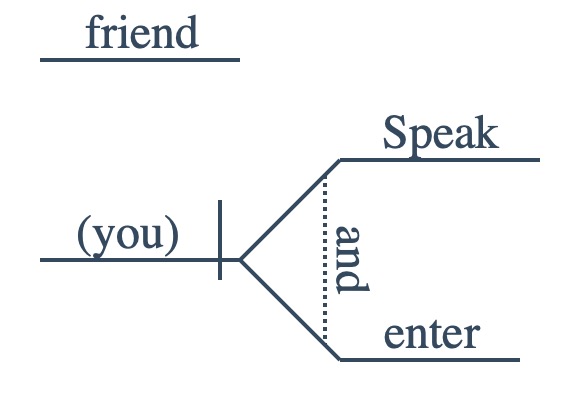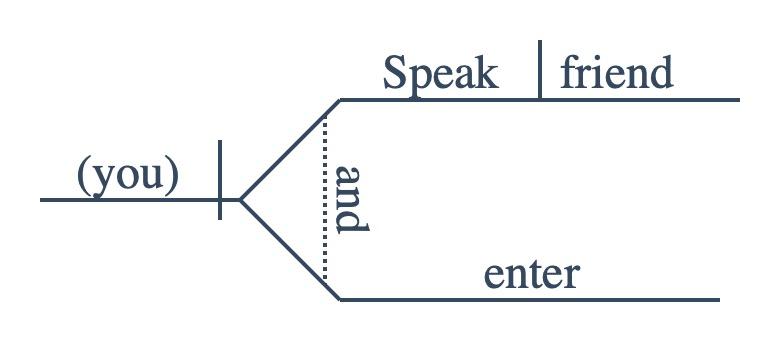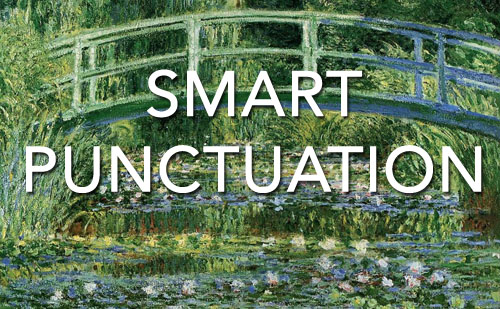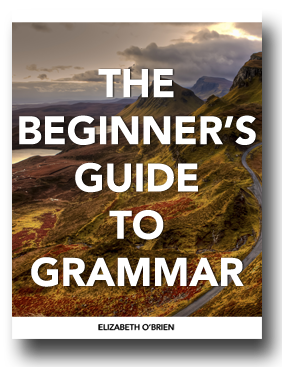Download your free grammar guide here.
Download your free grammar guide here.
Sentence Diagramming to Solve Tolkien's Riddle
Sentence Diagramming to Solve Tolkien's Riddle
- Home
- Diagramming Together
- Tolkien
If you're familiar with The Lord of the Rings: The Fellowship of the Ring, you may remember the scene where the heroes stand in front of the doors to the mines of Moria. In order to get in, they must solve a riddle.
However, Gandalf reads the clue aloud—but not with the correct punctuation. The clue can be understood in two different ways, depending on how it's punctuated. Take a look at these two versions:
1. Speak, friend, and enter.
2. Speak "friend" and enter.
Though these two sentences have identical words, their meanings change with different punctuation. Punctuation matters!
In this lesson, we'll break down each sentence and explore how punctuation changes the meaning. Using sentence diagrams, we’ll visually uncover how punctuation shifts the structure and understanding of the sentence. Let's go!
1. Speak, friend, and enter.

Speak, friend, and enter.
- Both of these sentences are commands (imperative sentences), and that means that they have the implied subject (you).
- Speak in this sentence is an intransitive complete verb. That means that it shows action, but it has no receiver of the action. Notice that there is nothing in the sentence diagram after speak.
- Enter is also an intransitive complete verb.
- And is a coordinating conjunction connecting the two verbs. The sentence diagram makes that easy to see!
- Friend is a a noun of direct address. Nouns of direct address speak to the listener or reacher of the sentence. They are not grammatically related to the rest of the sentence, which is why it's floating above the sentence in the diagram. It's like saying, "Speak, {your name here}, and enter."
What Does This Sentence Mean?
This sentence is a friendly command, where friend is calling out to the listener/reader and inviting them to speak. Once they speak, the doors will open and they can enter.
2. Speak "friend" and enter.

Speak "friend" and enter.
What's The Same
- This is still a command, so it also has the implied subject (you).
- Enter is still an intransitive complete verb.
- And is still a coordinating conjunction connecting the two verbs.
What's Different
- Speak in this sentence is still a verb, but it's a different type of verb. This verb is a transitive active verb. That means that it transfers its action to another word that we call the direct object. Notice that in the sentence diagram the line after speak extends and friend is written there. That's how we diagram these kinds of verbs.
- Friend is acting as a direct object of the verb speak. It's telling us what word to speak.
What Does This Sentence Mean?
This sentence is telling the reader to actually say the word friend aloud. Once they do that, the doors will open and they can enter.
Would you like to feel better about punctuation and make your writing as clear and impactful as possible? Join the Smart Punctuation Course! Learn more here.
Your organized presentation, including one concept at a time, made the material clear and graspable. I really enjoyed this class and found it very valuable. - Stephen B.
Thankfully, that clever Gandalf figured out what he needed to do. He spoke the word friend in Elvish, and the heroes were able to continue their journey! Congratulations, Gandalf, on knowing your punctuation!

Hello! I'm Elizabeth O'Brien, and my goal is to get you jazzed about grammar.
This is original content from https://www.english-grammar-revolution.com/diagramming-tolkien-riddle.html
Our Free Guide Gives You A Fun Way
To Teach And Learn The Basics v

Elizabeth O'Brien is the creator of Grammar Revolution.
Her lessons are guaranteed to give you more confidence in your communication skills and make you smile. :)

